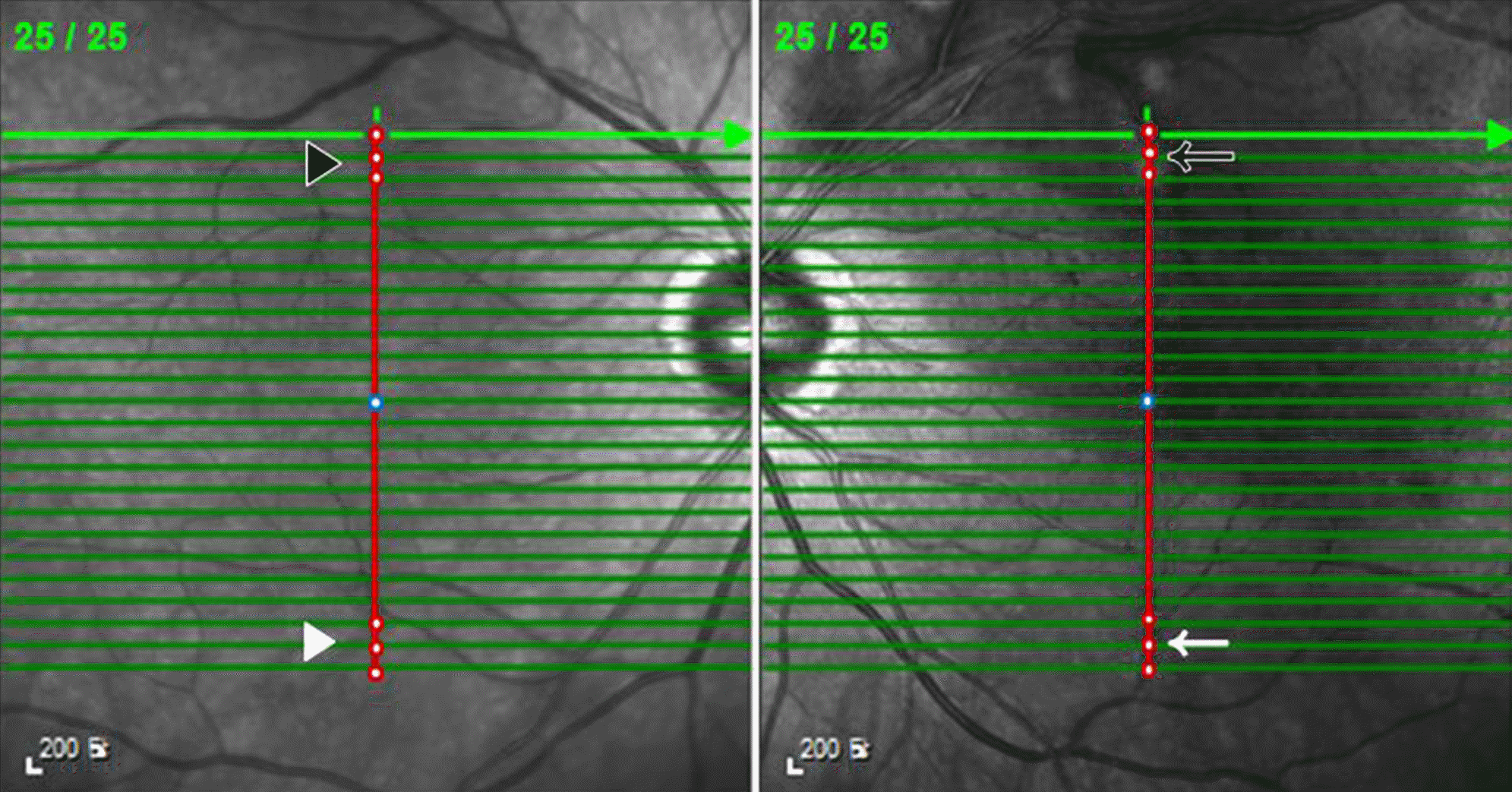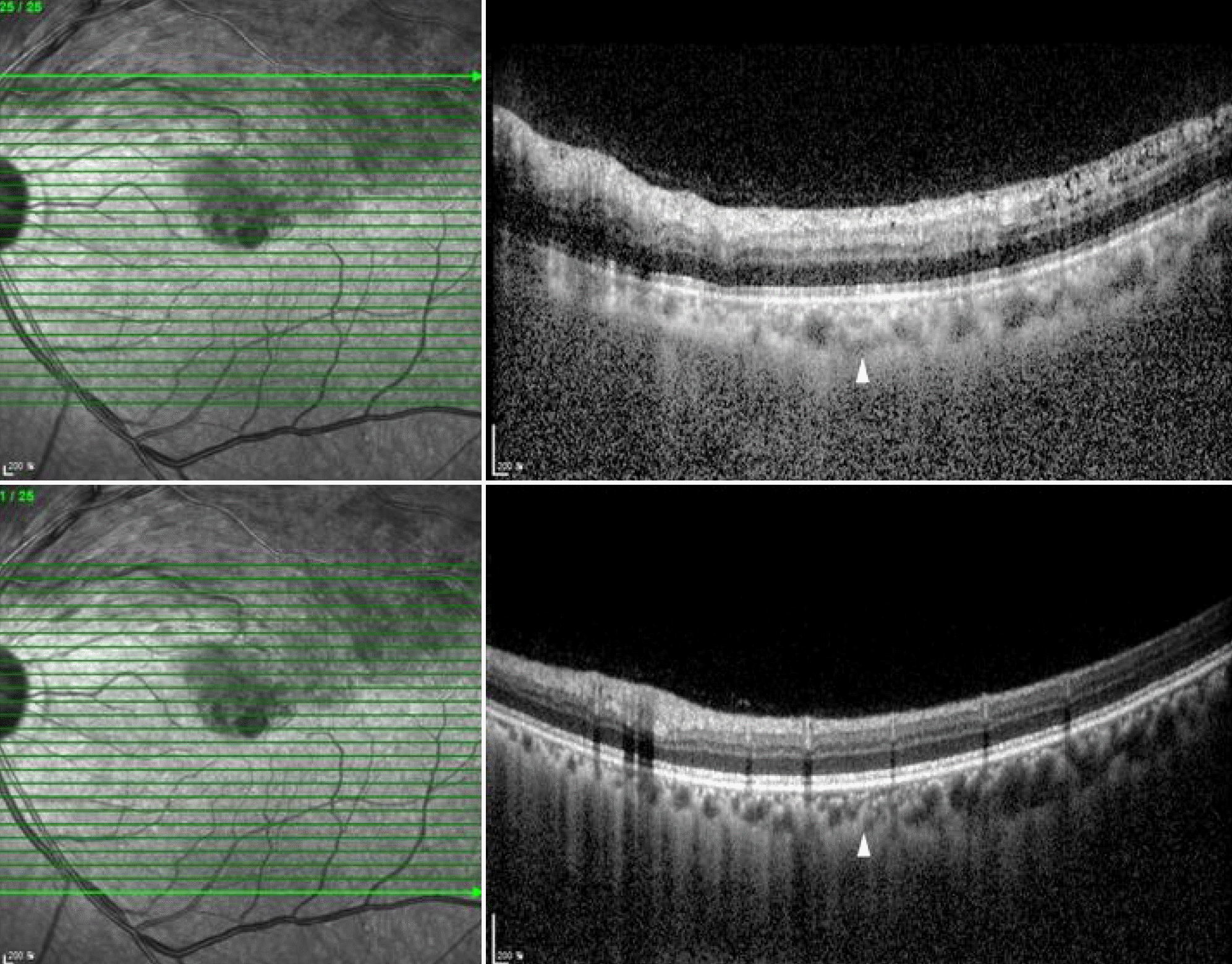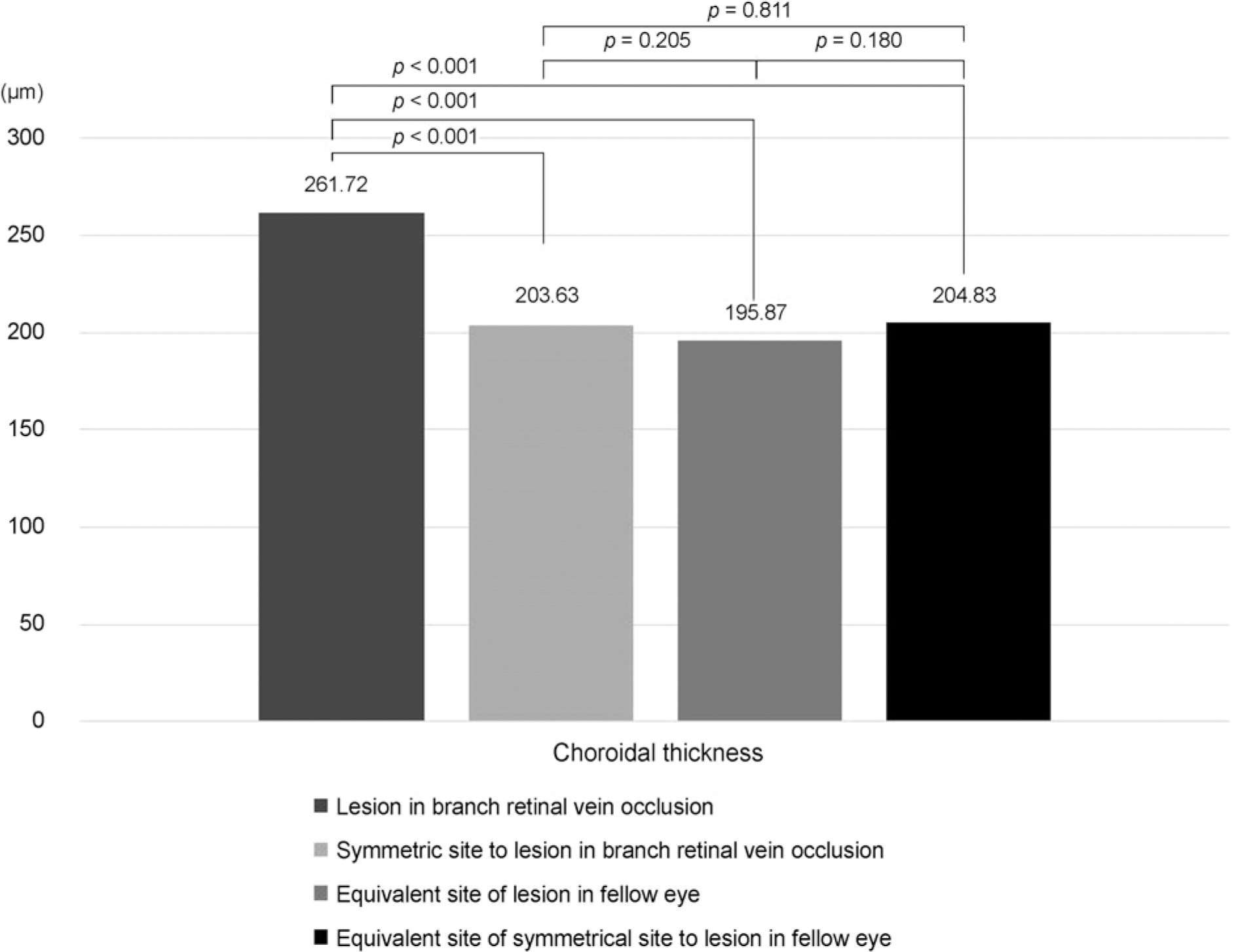Abstract
Purpose
To compare the choroidal thickness of a branch retinal vein occlusion (BRVO) lesion and that of other areas in the eyes.
Methods
Patients who visited the Ophthalmologic Clinic of Inje University Sanggye Paik Hospital for BRVO between March 2015 and October 2015 were reviewed retrospectively. We performed basic ophthalmologic exam and enhanced depth imaging optical coherence tomography in 48 eyes of 24 patients with BRVO. The choroidal thickness was compared in a total of 4 places, the branch retinal vein occlusion lesion, the symmetric site in the same eye, and the equivalent sites in the fellow eye by paired t-test. All measurements were performed by 2 independent observers.
Go to : 
References
1. Weinberg D, Dodwell DG, Fern SA. Anatomy of arteriovenous crossings in branch retinal vein occlusion. Am J Ophthalmol. 1990; 109:298–302.

2. Christoffersen NL, Larsen M. Pathophysiology and hemodynamics of branch retinal vein occlusion. Ophthalmology. 1999; 106:2054–62.

3. Uemoto R, Nakasato-Sonn H, Kawagoe T, et al. Factors associated with enlargement of chorioretinal atrophy after intravitreal abdominal for myopic choroidal neovascularization. Graefes Arch Clin Exp Ophthalmol. 2012; 250:989–97.
4. Tsuiki E, Suzuma K, Ueki R, et al. Enhanced depth imaging optical coherence tomography of the choroid in central retinal vein occlusion. Am J Ophthalmol. 2013; 156:543–7.e1.

5. Shin YU, Lee MJ, Lee BR. Choroidal maps in different types of macular edema in branch retinal vein occlusion using swept-source optical coherence tomography. Am J Ophthalmol. 2015; 160:328–34.e1.

6. Chung SE, Kang SW, Lee JH, Kim YT. Choroidal thickness in abdominal choroidal vasculopathy and exudative age-related macular degeneration. Ophthalmology. 2011; 118:840–5.
7. Fujiwara T, Imamura Y, Margolis R, et al. Enhanced depth imaging optical coherence tomography of the choroid in highly myopic eyes. Am J Ophthalmol. 2009; 148:445–50.

8. Imamura Y, Fujiwara T, Margolis R, et al. Enhanced depth imaging optical coherence tomography of the choroid in central serous chorioretinopathy. Retina. 2009; 29:1469–73.

9. Maruko I, Iida T, Sugano Y, et al. Subfoveal choroidal thickness in fellow eyes of patients with central serous chorioretinopathy. Retina. 2011; 31:1603–8.

10. Maruko I, Iida T, Sugano Y, et al. Subfoveal choroidal thickness abdominal treatment of Vogt-Koyanagi-Harada disease. Retina. 2011; 31:510–7.
11. Maruko I, Iida T, Sugano Y, et al. Subfoveal retinal and choroidal thickness after verteporfin photodynamic therapy for polypoidal choroidal vasculopathy. Am J Ophthalmol. 2011; 151:594–603.e1.

12. Du KF, Xu L, Shao L, et al. Subfoveal choroidal thickness in retinal vein occlusion. Ophthalmology. 2013; 120:2749–50.

13. Yuan A, Ahmad BU, Xu D, et al. Comparison of intravitreal abdominal and bevacizumab for the treatment of macular edema abdominal to retinal vein occlusion. Int J Ophthalmol. 2014; 7:86–91.
14. Campochiaro PA, Sophie R, Pearlman J, et al. abdominal outcomes in patients with retinal vein occlusion treated with ranibizumab: the RETAIN study. Ophthalmology. 2014; 121:209–19.
15. Aiello LP, Northrup JM, Keyt BA, et al. Hypoxic regulation of abdominal endothelial growth factor in retinal cells. Arch Ophthalmol. 1995; 113:1538–44.
16. Ku DD, Zaleski JK, Liu S, et al. Vascular endothelial growth factor induces EDRF-dependent relaxation in coronary arteries. Am J Physiol. 1993; 265(2 Pt 2):H586–92.

17. Tilton RG, Chang KC, LeJeune WS, et al. Role for nitric oxide in the hyperpermeability and hemodynamic changes induced by abdominal VEGF. Invest Ophthalmol Vis Sci. 1999; 40:689–96.
18. Ferrara N. Vascular endothelial growth factor: molecular and abdominal aspects. Curr Top Microbiol Immunol. 1999; 237:1–30.
19. Jirarattanasopa P, Ooto S, Tsujikawa A, et al. Assessment of abdominal choroidal thickness by optical coherence tomography and abdominalgraphic changes in central serous chorioretinopathy. Ophthalmology. 2012; 119:1666–78.
Go to : 
 | Figure 1.Method of measuring the choroidal thickness. Cross sectional image centered in macula (blue circle) was taken in the enhanced depth imaging mode with suprerior branch retinal vein occlusion (BRVO) in left eye. Black arrow points the lesion in BRVO. White arrow points the symmetrical site to lesion in BRVO. Black arrowhead points the equivalent site to lesion in fellow eye, and white arrowhead points the equivalent site of symmetrical site to lesion in fellow eye. Choroidal thickness was measured in 3 points (red circles) of each site. And the average choroidal thickness was calculated. |
 | Figure 2.Method of measuring the choroidal thickness. Cross sectional image centered in macula taken in the enhanced depth imaging mode with suprerior branch retinal vein occlusion in left eye. White arrowheads point the choroid-scleral junction. |
 | Figure 3.Comparison of choroidal thickness. Lesion in branch retinal vein occlusion was significantly thicker than others. All p-value by paired t-test. |
Table 1.
Characteristics of retinal vein occlusion patients
Table 2.
Mean choroidal thickness and interobserver correlation of measurements
| Location | Mean choroidal thickness (μ m) | Inter-observer correlation (r) | p-value* |
|---|---|---|---|
| Lesion in branch retinal vein occlusion | 262 | 0.94 | <0.001 |
| Symmetric site to lesion in branch retinal vein occlusion | 204 | 0.88 | <0.001 |
| Equivalent site of lesion in fellow eye | 195 | 0.92 | <0.001 |
| Equivalent site of symmetric site to lesion in fellow eye | 204 | 0.91 | <0.001 |




 PDF
PDF ePub
ePub Citation
Citation Print
Print


 XML Download
XML Download